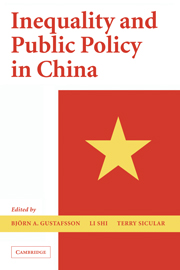Book contents
- Frontmatter
- Contents
- List of Tables and Figures
- Contributors
- Acknowledgments
- 1 Inequality and Public Policy in China: Issues and Trends
- 2 Income Inequality and Spatial Differences in China, 1988, 1995, and 2002
- 3 Growth and Distribution of Household Income in China between 1995 and 2002
- 4 Explaining Incomes and Inequality in China
- 5 The Distribution of Wealth in China
- 6 Growth, Inequality, and Poverty: A Comparative Study of China's Experience in the Periods before and after the Asian Crisis
- 7 What Has Economic Transition Meant for the Well-Being of the Elderly in China?
- 8 Inequity in Financing China's Health Care
- 9 China's Emerging Urban Wage Structure, 1995–2002
- 10 Unemployment, Earlier Retirement, and Changes in the Gender Income Gap in Urban China, 1995–2002
- 11 What Determines Living Arrangements of the Elderly in Urban China?
- 12 The Impact of Village-Specific Factors on Household Income in Rural China
- 13 The Redistributive Impact of Taxation in Rural China, 1995–2002: An Evaluation of Rural Taxation Reform at the Turn of the Century
- Appendix: The 1995 and 2002 Household Surveys: Sampling Methods and Data Description
- Index
- References
12 - The Impact of Village-Specific Factors on Household Income in Rural China
Published online by Cambridge University Press: 25 July 2009
- Frontmatter
- Contents
- List of Tables and Figures
- Contributors
- Acknowledgments
- 1 Inequality and Public Policy in China: Issues and Trends
- 2 Income Inequality and Spatial Differences in China, 1988, 1995, and 2002
- 3 Growth and Distribution of Household Income in China between 1995 and 2002
- 4 Explaining Incomes and Inequality in China
- 5 The Distribution of Wealth in China
- 6 Growth, Inequality, and Poverty: A Comparative Study of China's Experience in the Periods before and after the Asian Crisis
- 7 What Has Economic Transition Meant for the Well-Being of the Elderly in China?
- 8 Inequity in Financing China's Health Care
- 9 China's Emerging Urban Wage Structure, 1995–2002
- 10 Unemployment, Earlier Retirement, and Changes in the Gender Income Gap in Urban China, 1995–2002
- 11 What Determines Living Arrangements of the Elderly in Urban China?
- 12 The Impact of Village-Specific Factors on Household Income in Rural China
- 13 The Redistributive Impact of Taxation in Rural China, 1995–2002: An Evaluation of Rural Taxation Reform at the Turn of the Century
- Appendix: The 1995 and 2002 Household Surveys: Sampling Methods and Data Description
- Index
- References
Summary
Introduction
Setting the Agenda
In contrast to other chapters in this book that focus on the influence of individual and household factors on income inequality, this chapter places special emphasis on the impact of community on household income in rural China. The analytical focus is, first, on the significance of physical infrastructure, human capital, and social capital at the community level, and, second, on the role of public management and public policy at the local level. The estimation results of household income using a hierarchical linear model demonstrate that community-level variables have significant effects on household income, and their impact varies according to the type of community. Regarding public policy, the findings of this chapter suggest the importance of institution building to cultivate governing ability for rural cadres, to promote social stability, and to develop mechanisms to meet local needs for public services.
In the context of this chapter, the term “community level” refers to the administrative villages (xingzhengcun) that are at the lowest level of the party/governmental hierarchy (hereafter referred to as “village”). In relation to the main theme of the entire volume, this chapter focuses on the factors at the village level for two reasons, as follows.
First, by looking more closely at the influence of village characteristics we will be able to provide a fuller picture of the determinants of income inequality in rural China.
- Type
- Chapter
- Information
- Inequality and Public Policy in China , pp. 287 - 311Publisher: Cambridge University PressPrint publication year: 2008
References
- 4
- Cited by



